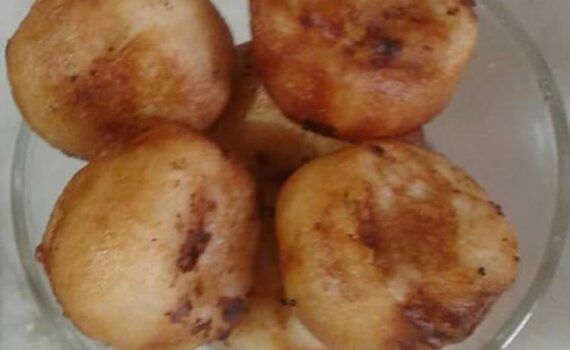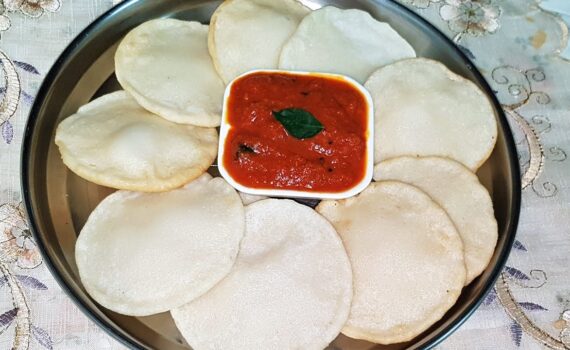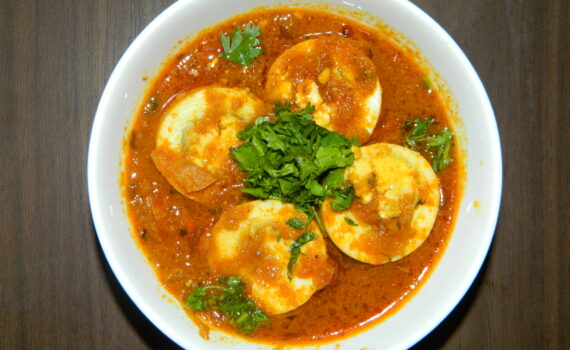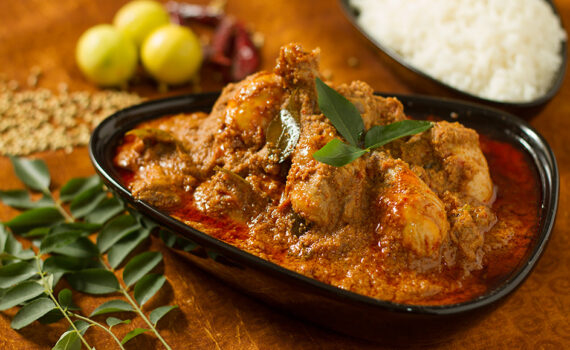Chettinad chicken gravy is a delectable and appetizing south Indian style chicken recipe produced by dry roasting masala spices, blending them into a paste, and then cooking the chicken in the masala.
It is a simple and quick recipe with a nice sauce that can be served with any main course meal such as roti, naan, or rice.
About the recipe
Many people may be asking why the recipe has this name, but let me explain. ‘Chettinad is a region of South India and a place in the Tamil Nadu region. Chicken delicacies are fairly famous in that region, and any dish form of chicken, be it a chicken fry or a chicken gravy, is very popular in that region.
Today’s recipe is entirely based on a chicken cuisine from the Chettinad region, which is a chicken curry prepared in their style and can be eaten with Malabar parotta.
I tried to provide a nearly identical and also wonderful gravy for this recipe, and I must say it is better than the restaurant bought one.
The masala used in Tamil Nadu chicken recipes or kulambu recipes mostly consists of roasted coconut, cumin, coriander, black pepper, whole spices such as cloves, cinnamon, and so on.
All of these ingredients are drily roasted, ground into a paste, and cooked alongside the chicken in an onion and tomato broth.
It is one of the most popular dishes in the South Indian region. Below is a list of the ingredients used in this dish, as well as a description of the flavor each one adds to the Chettinad chicken gravy.
Other non-vegetarian south Indian recipes on my blog include mutton kulambu, chicken fried, and so on.
Ingredients
Coconut: I used shredded fresh coconut, but desiccated coconut can be substituted if fresh coconut is unavailable.
To dry roast, use powdered or grated coconut, or small bits of raw coconut, as this will be combined and become a paste.
Whole spices: I used cinnamon, cardamom, and cloves, which add a wonderful scent to the gravy and make the curry entirely aromatic and fragrant.
In addition to these whole spices, I use black pepper to give the Chettinad curry a fiery flavor. The amount of these whole spices can be changed depending on the spice flavors desired by each individual.
I also added a bay leaf during the tempering process, which adds powerful, delightful notes to the curry.
Dried red chilies: Any dry red chili, such as Kashmiri red chilies or regular red chilies, can be used because different regions have different types of red chilies, but make sure they are dried.
This ingredient adds a spicy flavor to the dish, therefore adjust the amount according to the spice flavor of the chilies.
Fennel, often known as saunf, is a herb that aids digestion. This is also dry roasted and used to make the masala paste.
Coriander and cumin seeds: These are aromatic spices commonly used in South Indian recipes to create a unique and mouthwatering aroma and generate a tasty sauce when combined with other spices.
Without these two key spices, no cuisine is complete. Always dry roasting these ingredients makes the meal aromatic, and it only gives off the required smell if slightly roasted before powdering.
Onions and tomatoes: These two are used to give the gravy a base, and I have not pureed them, but have added them by slicing and frying them well before adding the masala paste, creating a good base for the stew.
Tomatoes add a slightly acidic flavor to the gravy and, if omitted, make the gravy slightly sweeter. As a result, tomatoes must be added to the curry.
Chicken: I use chopped chicken pieces with bones since the chicken with some bones releases juicy juices and tastes much better than boneless chicken. Clean the chicken thoroughly and, if possible, wash it with lemon and turmeric to remove any unwanted odors.
Curry leaves: Curry leaves are used in the tempering of South Indian gravies to provide flavor and taste.
Salt is a vital component of any recipe.
Oil: I used edible sunflower oil, but you could also use coconut oil, vegetable oil, or olive oil for a healthier alternative.
In a bowl, Chettinad Chicken Curry
Step by step procedure
Dry roasting the masala ingredients
- Get a pan and heat it. Combine cinnamon, cloves, cardamoms, black peppercorns, coriander seeds, and cumin seeds in a mixing bowl. Sauté the fennel seeds and dried red chilies for a few seconds before adding the rest of the dry ingredients.
- If the items are roasted for an extended period of time, they will emit a burnt odor.
- Arrange the roasted items on a platter.
- Cinnamon, cloves, cardamoms, black peppercorns, coriander seeds, and cumin seeds, roasted
- Roast the freshly grated coconut until it becomes a light brown color. To avoid burning, keep stirring and removing it as soon as it begins to brown.
- Allow all of these ingredients to cool somewhat before using.
Making the curry:
- Take a cooking saucepan, add some oil, and heat it. Sauté a bay leaf and a cinnamon stick for a few seconds. Sauté the sliced onions in it for a minute.
- Cook until the onions become tender and transparent.
- Slit green chilies and fresh curry leaves are added.
- Including ginger and garlic paste
- Adding diced tomato, mixing, seasoning with salt to taste, turmeric powder, and mixing
- Cook until the tomatoes have softened and become pulpy.
- Place all roasted ingredients in a blending jar, add 14 cups of water, and blend to a fine paste.
- blending all of the roasted ingredients into a fine paste
- On low heat, cook the masala until the oil leaves the sides, stirring occasionally.
- Cook the masala until the oil separates.
- Incorporate the chicken pieces into the curry.
- Mix it up.
- Cook the chicken for 5-10 minutes with the masala. Cook the curry, stirring frequently, until oil forms on the sides.
- Adjust the salt to taste, then add half a cup of water and stir everything together.
- Cook, covered, until the chicken is cooked, tossing occasionally.
- Both the chicken and the masala should be cooked thoroughly and should resemble a decent gravy with oil released at the corners.
- When the gravy is done, remove it from the heat.
- Serve hot with naan, parotta, or rice and garnished with chopped cilantro leaves.





